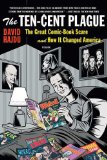The Comics Code Authority is little more than a rubber stamp these days, but in the 1950s, it was a last-ditch attempt to save the industry from a popular backlash against perceived immorality, primarily (but not exclusively) in crime and romance comics. (Though some people thought super-heroes were even worse.) Its restrictions, eventually relaxed during the 1970s, are no doubt responsible for many of the silly story elements of the Silver Age.
Check out the Illustrated Comics Code, which uses Golden Age comics panels to demonstrate just what the original version of the code prohibited. (Be warned: the first image on there is kind of gruesome. And misspells Wertham.)
 On a related note, I recently finished reading David Hajdu’s The Ten-Cent Plague: The Great Comic-Book Scare and How It Changed America. It’s a fascinating look at the early years of the comic book industry, the cultural landscape around it, and how a moral panic (not unlike current controversy over video games — actually, more or less exactly like current controversy over video games) nearly destroyed the industry.
On a related note, I recently finished reading David Hajdu’s The Ten-Cent Plague: The Great Comic-Book Scare and How It Changed America. It’s a fascinating look at the early years of the comic book industry, the cultural landscape around it, and how a moral panic (not unlike current controversy over video games — actually, more or less exactly like current controversy over video games) nearly destroyed the industry.
